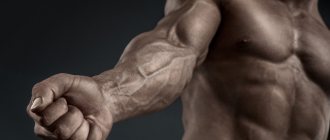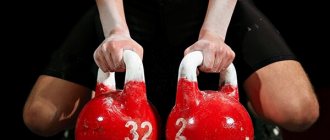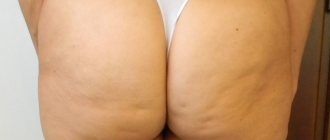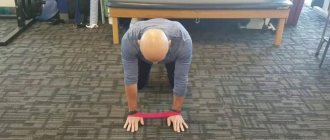And today there are even athletes among heart patients. However, for such people it is not sport that is more beneficial, but physical education. Moreover, it is simply necessary for many of them.
Proper exercise is beneficial for people with hypertension, coronary artery disease, heart failure and other heart diseases. They improve the quality of life, slow down the progress of the disease, and prevent the development of heart attacks, strokes, heart failure and other serious complications. If there is no exacerbation or decompensation of the disease, then moderate exercise is not only contraindicated, but also necessary. But it should be understood that the level of load depends on the state of the cardiovascular system, blood pressure, pulse rate, and pain syndrome. And only a doctor can determine it for sure. Therefore, if you are planning to engage in physical education, it is better to consult with him.
Article on the topic Winter and the heart. What can help you protect yourself from a heart attack?
How much and what is the best way to exercise? Here are some tips for hypertensive patients from the influential professional medical organization British Heart Foundation:
Try to exercise every day.
Your goal is at least 2.5 hours of study per week.
One session should last at least 10 minutes, and physical activity should be of moderate intensity. That is, your breathing rate and heart rate should be faster than usual, and you should feel warmed up. This happens when walking fast, cycling, or swimming.
Lifting weights and working with weights are undesirable, as they raise blood pressure higher.
Why is it necessary to stress the heart and blood vessels?
Physical activity helps:
- A decrease in the amount of C-reactive protein, which favors the appearance of inflammatory processes in the body.
- Reducing blood pressure and triglycerides.
- Raising good cholesterol levels.
- Regulating blood sugar and insulin.
- Weight loss.
Inactivity provokes problems with the heart and blood vessels. Cardiac training occurs when the strength of contractions increases and the heart rate increases during periods of stress. At the same time, the blood vessels are also trained.
Benefits of Cardio Exercise
Cardio training trains more than just your heart. In fact, aerobic exercise has positive effects on the entire body. Cardio improves immunity, saturates the body with oxygen, improves the condition of the skin and hair. There is a regulation of metabolic processes and hormonal levels. Improves mood, brain activity, performance and endurance. And most importantly, such training for the blood vessels of the brain, heart and lungs can prevent the development of diseases such as heart attack, stroke and diabetes! Isn't it a miracle? Do cardio workouts with FitCurves and stay healthy!
Exercises to train your heart
In fact, the range of such exercises is quite wide. Heart training is carried out through cardio and aerobic exercise. You can go jogging, ride a bike for at least half an hour a day, jump rope, swim in the pool, do aerobics and step, dance, or just take walks for 20 minutes in the evening, and give up the elevator. It is recommended to adhere to the following rules:
- The optimal heart rate is one hundred twenty to one hundred thirty beats (not higher than 130 and lower than 110).
- You cannot arrange training sessions lasting more than an hour (for weak blood vessels - 30 minutes).
- Conduct these classes two or three times during the week.
Heart training by running is also beneficial. Don't turn it into a routine. Jogging three or four times a week for 20 minutes, monitor your condition. If you feel any discomfort, go for a walk.
Cardiac endurance training: what is it and why is it needed?
The heart is an organ that works constantly, continuously pumping blood throughout the body. Therefore, it itself is very strong and resilient. However, like the whole body, it needs additional exercise and training. Only a pumped heart can provide a person with endurance and endurance during serious physical exertion. Even if you are one continuous pile of muscles, sculpted and beautiful, but the “motor” of your body is weak and not prepared for stress, then after just a few minutes of intense running you will begin to choke, turn red and break out in sweat. It’s good if it all ends there, but the consequences of stress on an untrained heart can be much more tragic.
Many people have probably heard about cardio training at least once. Most experienced athletes successfully use this type of training in practice to achieve their goals.
Other factors
Stress, environment and nutrition gradually bring blood vessels into increased tone, which affects blood pressure. In such a situation, do not rely only on the help of pharmaceutical drugs; you need to restore full blood circulation, and above all in the capillaries. Training your heart and blood vessels will help you with this. Vibration exercises will be effective: in the morning in bed, raise your arms and legs, shake them for about two minutes. This is how the capillaries are vibrated and the lymph is redistributed, through which the body is cleansed of toxins and waste. It is advisable to repeat the exercise in the evening before bed.
If you experience frequent spasms of cerebral vessels, causing high blood pressure, nausea, memory, speech, and motor coordination problems, you need to work on strengthening them by organizing a healthy diet, using medications, and physical exercise. You can perform head rotations in one direction and the other for two to three minutes, as well as bending forward simulating chopping wood. Swinging your legs forward (left leg to right outstretched arm) is effective. You can rotate your arms asynchronously (left forward, right backward), and do a “birch tree” backstand. The exercises are performed very smoothly. If the neck muscles are weakened, they often tense and put pressure on the blood vessels, impairing blood circulation. Their training helps restore the functioning of blood vessels and cure the effects of compression.
Stagnation of blood in the legs affects the veins. To strengthen the blood vessels in the legs and improve their functioning, it is recommended to walk on your knees back and forth. It is necessary to bend forward with straight legs, while reaching the floor with your fingers. This exercise is very useful for the veins of the legs: take a large rolling pin or a plastic bottle of water, kneel down, put the bottle on your calves, sit on top and, as it were, ride it from your knees to your ankles and back. It is useful to jog slowly, and if there is discomfort, start walking.
Exercises at home
Heart training, muscle and vascular training can also be done at home. For example, squats next to the door. You need to squat while holding the door handles, knees in line with your toes. Start with a small number of repetitions, bringing them up to 100 in 2 months, then more. First, squat twenty to thirty centimeters, after a month - deeper. The muscles of the heart, spine and legs are strengthened. And contractions of the leg muscles help the blood flow upward through the veins.
In recent years, Nordic walking with poles has become popular. Try to walk rhythmically, naturally, working with your arm and leg at the same time. Exercises like this are a great outdoor workout for your heart!
Listen to your heart
The easiest way to find out how your heart is working is to count your pulse.
On the inside of the forearm, next to the hand, as well as on the temple, on the outer surface of the foot, you can find slightly protruding blood vessels - arteries, in which the movement of blood through the vessels is given. The pulsation of the artery wall occurs when the heart contracts, throwing out another portion of blood. The blood hits the wall of the largest artery, the aorta, and stretches it. It's like hitting a rubber tube. Its stretching wave is transmitted through other vessels and reaches those arteries that we press with our fingers to feel the pulse. Every pulse beat is a beat of your heart. To make sure it is working properly, you need to count the number of beats per minute. Ideally there should be about seventy of them. However, the heart rate quite naturally increases during physical activity and emotional experiences. If you do 10–20 squats, your heart rate can reach 100 beats per minute or more.
The same will happen if something makes you very happy or frightens you. Why this happens is completely clear: in a situation of stress, the body strives to give the cells more oxygen and nutrients, the heart receives the corresponding signal and begins to beat faster so that the cells receive more blood. However, over time, everything returns to normal, and the pulse also returns to values close to 70–75 beats per minute. By how quickly this happens, you can also judge the work of the heart.
What else should you pay attention to?
In addition to physical exercise:
- Stop smoking.
- Lose weight if you are overweight.
- Follow your doctor's recommendations for taking medications.
- Eat less salt.
- Sleep 8-9 hours.
- Eat a varied, wholesome, healthy diet.
The heart muscle is well nourished and strengthened by Panangin, which affects metabolic processes in the heart, improves its functioning, prevents early aging of the myocardium, and prevents the appearance of atherosclerosis, high blood pressure, and arrhythmia. It is recommended for healthy people as a means to strengthen the heart muscle and for the prevention of vascular diseases. Panangin contains potassium and magnesium, which can also be obtained daily from food. Eat spinach, seaweed, lentils, oatmeal, sunflower seeds, wheat bran, flax oil, fish oil to cleanse blood vessels.
Basic rules for training
Any exercise can pose a health hazard if not performed correctly. People suffering from hypertension or those who have recently had a heart attack, stroke or surgery need to be more careful when choosing the type of physical activity. Patients with bronchial asthma are also at risk.
At the very beginning of any training, it is necessary to warm up. Without this, there is a high probability of ligament rupture, muscle overextension and joint damage. Warm-up should be comprehensive and take at least 10 minutes.
For those who suffer from excess weight, activities that involve increased axial load, such as running or jumping rope, are not recommended. Due to increased body weight, greater stress is placed on the knees and ankles, which can lead to injury and premature wear of the joints. In such cases, training on exercise bikes would be the best option. By adjusting the degree of resistance of the pedals, it is convenient to control your pulse and exercise in a certain heart rate range.
When exercising on a treadmill or during regular running, you need to push off with your toes and then move your foot to your heel. This technique allows you to absorb pressure and distribute it evenly along the lower limb, without focusing the load on a particular joint.
Heart training: pulse and its indicators
How to determine the intensity of training to achieve results? We determine the maximum heart rate, it is individual. You need to subtract the number of your age from 220. The result obtained is your maximum heart rate. The heart improves at 50-60% of the maximum heart rate. At the same time, the condition of the cardiovascular and respiratory systems improves. A rise in heart rate to 80% of the maximum covers a larger number of blood vessels, pulmonary ventilation increases, and the size and strength of the heart increases. Training in the red line zone (80-90% of the maximum) is carried out in good physical shape, under medical supervision.
What type of training should you choose?
There are a wide variety of cardio workouts, and you can choose the one that best suits your lifestyle and personal preferences: Rollers are a great option for those who want to have slimmer legs and stronger thighs. With the right motivation and regular exercise, you can even get rid of cellulite. A stepper is a good cardio exercise option for those who want to pump up their gluteal muscle. Running develops the heart, blood vessels and lungs. Increases endurance. Helps cope with depression, affects metabolism and regulates hormonal levels. Nordic walking has all the benefits of walking and is extremely enjoyable. Bicycle – While cycling, almost all muscle groups are involved. Develops the muscle corset, strengthens the cardiovascular system. Swimming trains the respiratory system and uses the muscles of the whole body. Water soothes, relieves tension, and relaxes tight muscles.
We are developing further
Don't forget that training your heart and developing your endurance should receive equal attention. All stages of increasing the intensity of exercises must be completed gradually, slowly, so as not to harm the heart and blood vessels and develop their endurance. The key to success is regularity. If you go to the pool or ride a bike several times a week, then morning exercises should be done daily. In addition to the previously recommended shaking and turning, we recommend a number of exercises for the heart and blood vessels:
- Walking on your toes, raising your knees high.
- Hands above your head in a lock, legs apart. Deep bends to the sides.
- Hands to the sides, bring them together, slap your shoulders.
- Rotation of the arms forward - up - back and vice versa.
- Simulation of cycling in a lying position.
- Cross-shaped movements of the legs at a height of 30-40 centimeters from the floor in a lying position.
We remember: it is not the number of exercises and the intensity of the load that is important, but the regularity. The load should increase gradually. After it, relaxation is necessary so that the muscle fibers increase, and the heart muscle and blood vessels are strengthened, and their endurance increases.
How to strengthen your heart: exercises
We have collected for you the most useful and convenient physical exercises to strengthen your heart, which will allow you to prevent the occurrence of many cardiovascular diseases and stabilize blood pressure.
- Spread your arms so that your shoulder blades on your back touch each other. The chest should be straightened forward, opening the diaphragm as much as possible. You need to spend at least a minute in this state. The repetition frequency can reach five times. Exercise makes the heart work easier.
- Stand barefoot on a flat floor, feet shoulder-width apart, toes pointing slightly inward. The knees are slightly bent, the body is relaxed. While in this position, you need to slightly lift your heels off the ground, literally one centimeter, and smoothly lower them. From the outside, the exercise should resemble a slight shaking of the body. Moreover, the intensity of raising and lowering the heels should not exceed once per second. It is best to do the exercise in sets, rise and fall ten times, rest for five seconds, then repeat everything again. It opens the venous valves and improves blood circulation.
- Shaking the body is also very useful (cannot be done if there are blood clots); to perform them, you need to take a comfortable position, legs together, arms raised. Shaking is also best done in sets, shaking for thirty seconds, resting for thirty seconds.
- It is recommended to perform this exercise next to a tree or some kind of vertical pipe (support). You need to grab it with both hands, become comfortable and start squatting. At first, the squats may not be full, but after two weeks they should reach their maximum amplitude. The number of squats in one day can reach three hundred times. You can perform them throughout the day, as you have free time. The exercise is truly unique; it was developed by Russian professor Ivan Neumyvakin specifically for people suffering from heart disease, who have suffered a stroke or heart attack.
Strengthening the heart and folk recipes
It is very important that the heart muscle receives the necessary vitamins; training alone cannot do this. Here are some tips from healers:
- Mix chopped dried apricots, walnuts, figs, lemon with peel, raisins, honey. Take 250 grams of everything. Keep refrigerated. Take a tablespoon three times a day.
- Take a tablespoon of hawthorn for one and a half glasses of water and boil for thirty minutes. Drink a quarter glass three times before meals.
- Take 10 grams of lemon balm, St. John's wort, birch leaves, 30 grams of fireweed. Steam a tablespoon per 300 ml of water. Take a glass three times a day.
- Place a tablespoon of buckwheat in 500 ml of water and leave for 2 hours. Drink one glass three times.
- Pour five tablespoons of rosemary herb into 100 ml of vodka and leave for 7 days. Take twenty-five drops three times half an hour before meals.
Be healthy!











